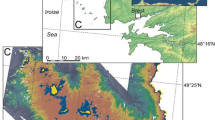Abstract.
Shells of the bivalve molluscs Chamelea gallina L. and Callista chione L. from the Bay of Trieste (northern Adriatic) were analysed for their oxygen and carbon isotopic composition. The main purpose of this study was to obtain detailed information on the biological behaviour and, particularly, on the growth rates and the settlement time of these two species. Isotopic measurements were carried out on "spot" samples collected from the umbo to the ventral margin of each shell. The results obtained from nine specimens of C. gallina (plus some 20 specimens studied only for the isotopic composition of their initial umbo and for the last section of their ventral edge) and from two specimens of C. chione allow the following conclusions: (1) the calcium carbonate of C. gallina shells is not deposited under isotopic equilibrium conditions with the environmental variables (temperature and oxygen isotopic composition of seawater); (2) this species usually initiates precipitation of carbonate during the springtime, although some late summer–early autumn generation also occurs; (3) the rate of calcium carbonate deposition decreases with increasing age, and the overall accretion rate is a rather slow one; (4) there is a negative correlation between the carbon isotopic composition and the size of each shell; (5) the mean growth rate of the shells can be easily evaluated according to the oxygen isotopic composition of the spot measurements; (6) the specimens of C. chione do not precipitate the calcium carbonate of their shells in isotopic equilibrium with environmental conditions; (7) their accretion rate is rather fast during the first years of their life and progressively and considerably reduced after about 5 years; (8) the carbon isotopic composition of these shells does not show the marked evolution towards more negative values shown by C. gallina, suggesting that neither respiratory CO2 nor carbon species derived from the oxidation of organic matter are systematically used for the precipitation of shell carbonate; and (9) a marked preference for the warmer half of the year is shown by the oldest specimen of C. chione (12 years).
Similar content being viewed by others
Author information
Authors and Affiliations
Additional information
Electronic Publication
Rights and permissions
About this article
Cite this article
Keller, .N., Del Piero, .D. & Longinelli, .A. Isotopic composition, growth rates and biological behaviour of Chamelea gallina and Callista chione from the Bay of Trieste (Italy). Marine Biology 140, 9–15 (2002). https://doi.org/10.1007/s002270100660
Received:
Accepted:
Issue Date:
DOI: https://doi.org/10.1007/s002270100660




